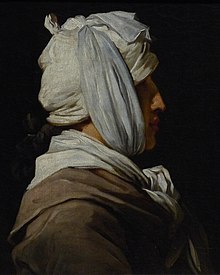|
Anicet Charles Gabriel Lemonnier
    Anicet Charles Gabriel Lemonnier (male; 6 June 1743 – 17 August 1824) was a well-known French painter of historical subjects who was active before, during and after the French Revolution. LifeLemonnier was born in Rouen on 6 June 1743. He was a pupil of Jean-Baptiste Descamps at the Rouen School of Fine Arts, then of Joseph-Marie Vien, where he had as classmates and friends Jacques-Louis David and François-André Vincent. With a pleasing appearance, much natural wit and excellent recommendations he was soon admitted into the best society in the capital, especially in the salon of Marie Thérèse Rodet Geoffrin, who took a liking to him. In 1772 he exhibited The Children of Niobe killed by Apollo and Diana, a work that won him the Prix de Rome. He lived in Rome, as a licensee of the Government, from 1774 to 1784. In this country of the arts, Lemonnier found a home full of kindness with the famous poet diplomat, Cardinal de Bernis, and devoted himself with enthusiasm to the study of masterpieces of the masters, from which he drew inspiration for the design and composition that is distinctive of his talent. Back in France, Lemonnier returned to his hometown where he painted one of his best pictures, the Plague of Milan, for the chapel of the Seminary of Saint-Vivien. In 1786, during the visit of Louis XVI to Rouen on his return from Cherbourg, Lemonnier was commissioned to paint a picture whose subject was the presentation of the members of the Rouen Chamber of Commerce to the monarch. Soon after, he performed for the same company a large allegorical painting representing the engineering trade and the discovery of America. In 1789 Lemonnier was named to the Academy of Painting for his work la Mort d’Antoine (the Death of Anthony). During the French Revolution, Lemonnier was called to be part of the Committee on Monuments, and in 1794 he obtained the title of the cabinet painter of the School of Medicine. Related to Roland, on 4 December 1792 Lemonnier received from the minister a position at the Louvre which placed him on the Arts Commission, where he rendered great service. In Rouen he was charged, with his compatriot Charles Le Carpentier, to examine art works removed from suppressed religious institutions in the district and select those that should avoid destruction. He discharged this critical mission with great zeal, and it is due to Lemonnier that several churches and the museum of Rouen now possess many of the best paintings he managed to collect. In 1810 Lemonnier became director of the Gobelins Manufactory, a position he lost in 1816. He also took an active part in establishing the Museum of Fine Arts of Rouen. He died in Paris on 17 August 1824. Lemonnier's son, André-Hippolyte Lemonnier, was a man of letters who wrote, among other things, a historical record of the life and works of A.-C.-G. Lemonnier. Lemonnier's portrait is in the collection of Rouen Library. WorksLemonnier's works include An Evening with Madame Geoffrin, executed in 1812 for the Empress Josephine. This painting exhibited at the Musée des Châteaux de Malmaison et Bois-Préau is an imaginary reconstruction of the salon of Marie Thérèse Geoffrin depicting, among others, the ministers Choiseul, Fontenelle, Montesquieu, Diderot and Marmontel, their hostess and a bust of Voltaire in a scene where the actor Lekain is reading Voltaire's play L'Orphelin de la Chine (The Orphan of China). Several drawings by Lemonnier have survived and are in French museums, including:[1]
References
Further reading
External links
|
||||||||||||
